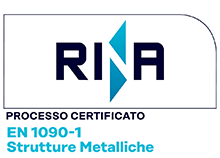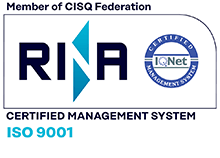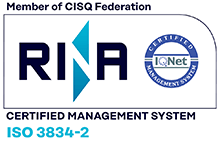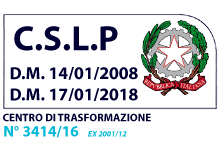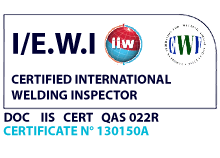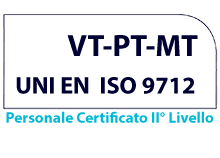UNI EN 1090 Fast Certification?
In the last period a lot has been said about ways to certify carpentry and systems that are more or less facilitated to obtain certification, also thanks to the collaboration of Entities and Organizations that tend to deal with the topic with superficiality or worse still as it goes to say to the Italian (ie not taking things seriously but focusing on what can be the possible escamotage, to overcome the problems and demands of the regulatory system)
By making an explicit reference to the activities of the carpentry production workshop:
Initial Situation (from DM 16/01/1996 to N.T.C. 2008)
During this period there were no limitations for workshops that intended to carry out structural structural carpentry other than the ability of the product to commission the product in terms of equipment and space, so no specific knowledge was required, as well as no qualifications needed of staff or production controls, simply anyone who thought he was able to do a particular job could do it.
n practice chaos reigned the only way to overcome the lack of regulatory references, it was in some cases the professionalism and experience of some designers or builders.
Recent History. (N.T.C. 2008)
Anyone without any exclusion to provide construction material or more generally to build structural carpentry is required in law to register his company to the Higher Board of Public Works as a Steel Conversion Center.
Buildings or structures are divided mainly between:
- Structures subject to fatigue or turmoil
- Structure subject to static stress!
This step required a great deal of effort for companies wishing to build carpentry, as without distinction between number of employees, turnover classes or type of work, all must undergo the same process as:
- The implementation of a Quality Management System UNI EN ISO 9001 certified by a Notified Body
- The implementation of quality management system for the welding process UNI EN ISO 3834 Certification, which provides different degrees of application depending on the type of construction to be carried out (eg 3832-2 for structures subject to fatigue or earthquake or 3834 -3 for static structures), which includes the following points:
- Use for welding operations of qualified personnel (the famous welder patents) according to UNI EN 287 now UNI EN 9606, issued by a notified body;
- Use of WPS (Welding Procedure Specification or shortly a document to be supplied to the welder with all welding and joint preparation parameters) produced according to UNI EN 15609;
- Qualified welding procedures UNI EN 15614 (single system provided) issued by notified body;
- Possession of staff responsible for covering the role of co-ordinator of welding;
- Warehouse management and related traceability of base material and supply material;
- Management of equipment with relative periodic maintenance in order to ensure continuous initial efficiency and constancy in the process;
- Integration within its own staff for VT visual inspection (100% for all joints) 2nd degree certificate according to UNI EN 473 now become UNI EN 9712
- Integrating within its own staff of professional figures responsible for the role of Technical Director of Establishment, who necessarily has to be a technical professional enrolled in his / her membership register (order or college), among the various tasks of the DTS are:
- Supervision of production activities;
- Checking acceptance of base material by sampling to be tested as provided in §11.3.4.11.2.3 of D.M. 14/01/2008;
- Recording the results of the checks performed as in the previous point;
- Complex document management, as it increases the amount of documents to be produced for each single order then to be kept for legal terms (at least 10 years)!
Without going into further detail, it is obvious that all this work and commitment has undoubtedly increased the quality of the products provided or realized, and the professionalism of companies involved in guaranteeing and protecting the final customer and civil society, all this also against competition European, to get all this, companies have had to make significant investments in economic terms, which some unfortunately have managed to avoid bypassing the requirement, using misinformation or the conviction of buyers and professionals!
It should be remembered that since 1 July 2009 the application of the Technical Standards for Construction became mandatory, it is from that date that the various Works Offices engaged throughout the national territory would no longer be able to receive on a material site that was not produced according to the requirements of the NTC, then the Transformation Centers in the case of steel;
Current situation (UNI EN 1090-1)
Anyone without any exclusion to provide construction material or more generally to build structural carpentry is obliged in law to provide the CE marking of their products!
As is well known, UNI EN 1090 classifies constructions according to 4 execution classes, starting from EXC1 (for simple structures of absolutely no relevance and importance) up to the EXC4 class (for structures of national strategic importance or for civil protection purposes)
Certification for CE carpentry marking can be obtained by submitting its own FPC (factory production control) to the examination of a Notified Body!
According to the UNI EN 1090-1 standard, factory production control or FPC between the following points:
- requires the application of an organizational methodology, in this case the requirements of the UNI 9001 are considered an acceptable method (in the case even if a certified system does not require a proof of application);
- requires the implementation of a quality management system for the welding process conforming to UNI EN ISO 3834, which envisages different degrees of application depending on the type of construction to be manufactured (eg 3832-2 for structures subject to fatigue or turmoil or 3834-3 for static structures) of particular importance for welded structures since it is then promptly recalled by UNI EN 1090-2 "Execution of steel structures" (a certified system guarantees the evidence of application), the correspondence between the EXC execution classes and the different levels of UNI EN 3834 and defined by the UNI EN 1090-2 standard, the points for UNI EN 3834 for the CE marking are:
- Use for welding operations of qualified personnel according to UNI EN 9606;
- Use of WPS produced according to UNI EN 15609 for welding activities, including pre-assembly and repair activities;
- Qualified welding procedures UNI EN 15614, UNI EN 15613, and only for EXC2 execution class, it is possible to use the qualified procedures according to UNI EN 15612;
- Having qualified / certified staff to serve as a welding coordinator in accordance with UNI EN 14731, this figure in particular plays a key role in the organization's activities!
- Warehouse management and related traceability of base material and supply material;
- Management of equipment with relative periodic maintenance in order to ensure continuous initial efficiency!
- Adoption within the organization of VT visual inspection staff (100% for all joints) 2nd degree certificate according to UNI EN 9712 (ex UNI 473)
- Integration of visual controls with other methods whose extension is always defined by the UNI EN 1090-2 standard based on the performance classes with penetration (PT) or magnetic particles (MT) for all activities related to PND ( Non Destructive Testing) the staff must always be certified 2nd level according to UNI EN 9712.
- The figure of the Technical Director of establishment is no longer necessary, now the responsibilities are from the manufacturer, or the person who signs the performance statement (DOP), and can use external figures to verify compliance, common case and assignment to welding coordinator!
- Document management that as for N.T.C. is complex, as it increases the amount of documents to be produced for each single job, including designs, designs, reports, certifications, and more than anything to keep for the law (at least 10 years)!
It is obvious that this certification represents the natural evolution of the N.T.C., which is now evolving from national legislation towards free trade and transit of goods within the European Community, being UNI EN 1090 European legislation applicable throughout the territory without restriction!
Companies that in previous years had activated to operate in accordance with N.T.C. obviously have the advantage of obtaining certification, and with relatively little effort they can adapt to the new legislation without any particular burden (precisely because much of the work has already been done in a serious way in previous years), continuing to improve qualitatively the work and prestige of a category absolutely fundamental to the Italian economy, such as that of the buildings (in this case related to steel), while for companies that for the most disparate reasons are looking to produce carpentry without experience in the field it becomes necessary commitment and a remarkable investment in terms of human and economic resources to achieve the same qualitative and organizational standards of the previous ones!
So we personally feel that we are responding to mails, faxes or communications of various kinds and genres that are promptly delivered to us, and which we imagine are widespread, with titles of the kind: "... REGISTER NOW WITH ... omissis ... "," IF YOU WANT TO CREATE SURE AND COSTS CONTAINED IN THE CERTIFICATION ... "," ... WE PROVIDE THE CE MARKING ON YOUR PRODUCTS ... ", etc ... etc ... that one product certification "easy", "immediate", practically uncompromising, almost by buying it from office absolutely does not need anyone, from the buyers to the technicians to end up to the various categories involved are all penalized, except to those who publicize it playing on the targeting, aiming information and possible voids or regulatory gaps, denigrating the work and commitment of the many companies that have been committed to working and respecting recognized standards in recent years, "product certification is not necessary that is f acute or immediate, but it must be serious, which can be a distinctive title for the organizations that adopt it and believe it "and that it will allow Italian companies to compete and become more successful on the European and international markets!
To conclude on the basis of these considerations it is absolutely essential to rely on certified companies with EXC-3 execution class, and later as:
- this execution class "does not allow shortcuts" of any kind to obtain the certification itself, unless seriousness is the commitment of the organizations they intend to achieve;
- it does not represent an additional burden for the designers who want to entrust their works except for a quality guarantee;
- is the most effective way to reward qualitatively and professionally the companies that are so popular and widely spread throughout the Italian territory that as ours have immediately engaged in the certification process!
Purpose and scope of the UNI EN 1090-1 standard
Dall'entrata in vigore della norma (UNI EN 1090-1:2011), si è fatto un gran parlere di quale sia il campo di applicazione, e o i prodotti coperti dalla marcatura CE con la suddetta norma, recentemente sul sito della commissione europea http://ec.europa.eu/ nella sezione Frequently Asked Questions on the Construction Products Regulation (CPR), è stato reso pubblico il parere della commissione con un elenco non esaustivo di prodotti su cui è possibile apporre il marchio CE.
#31 When does the CE marking have to be affixed on the basis of EN 1090-1:2009+A1:2011?
The CE marking has to be affixed on a construction product on the basis of the harmonised standard EN 1090-1:2009+A1:2011 when all the following conditions are satisfied:
- the product is covered by the scope of EN 1090-1:2009+A1:2011 (please find the indicative, non-exhaustive list of products (266 kB) not covered by the scope of EN 1090-1:2009+A1:2011 as provided by CEN),
- and the product is a structural construction product within the meaning of the Construction Products Regulation (EU) 305/2011 which means:
- the product is intended to be incorporated in a permanent manner in construction works (buildings or civil engineering works), and
- the product has a structural function in relation to the construction work (i.e. its failure will affect the satisfaction of Basic Work Requirement 1 as detailed in Annex I of Regulation EU 305/2011).
- and the product is not covered by a dedicated European product specification (because if a specific harmonised EN, or an European Technical Approval Guideline (ETAG) or an European Technical Approval, or an European Technical Assessment (ETA) for this product exists, the basis for the CE marking is the relevant specific harmonised EN, or the ETApproval, or the ETAssessment).
Note 1:Wind turbines and their towers cannot be CE marked under EN 1090-1. They are subject to the Machinery Directive (MD) and the complete wind turbine system must be CE marked thereunder. One of the essential requirements of the MD is the stability of the machine. Thus, the obligatory CE marking under the MD also covers the stability of the wind turbine. The application of the CPR, in addition to the MD, would not cover additional performance aspects. Furthermore, wind turbine towers are not considered to be construction products under the CPR. Nevertheless, wind turbine towers can be assessed by EN 1090-1 (or others) in order to fulfil the stability requirements under the MD.
Note 2:'Common' fences and railings (balustrades) which merely have the function of preventing a person from falling are not structural products because they do not support (a part of) the structure. In general their failure will affect the satisfaction of Basic Work Requirement 4 – Safety and accessibility in use (as detailed in Annex I of Regulation EU 305/2011) rather than Basic Work Requirement 1 (mechanical resistance and stability). For this reason, these common balustrades cannot be CE marked on the basis of standard EN 1090-1. However, balustrades which do have a role in supporting the structure of the construction work or parts of it have a structural function, i.e. their performance may affect the mechanical resistance and stability of e.g. a building AND they prevent a person from falling, thus are covered by EN 1090-1 and must therefore be placed on the EU market with a DoP and the CE marking.
Note 3: Elaborations under Note 2 also apply to staircases.
From the answer it is clear how the CE marking should be applied whenever:
- The product is covered by the purpose of the UNI EN 1090-1 + A1: 2011 standard, ie the product is not present in the list that you can freely consult in English list of products
 ,it remains to be understood that this list is not exhaustive and complete
,it remains to be understood that this list is not exhaustive and complete - it can be seen that many of the exclusions are to be covered by products covered by appropriate harmonized standards, such as in the case of gates certified according to UNI EN 13241-1 or in the case of cold-formed cold-formed steel pipes (tubes) UNI EN 10219-1 or ETAG technical approvals as in the case of mechanical anchors (dowels), different is the case of decorative elements that do not function as structural elements, hooks or crane components because they are subject to machinery pipes and tanks because they are subject to PED directive, these products obviously can not be subject to CE marking according to UNI EN 1090-1.
- The product is a structural construction product under the Construction Products Regulation (UE) 305/2011, which means that:
- the product is intended to be incorporated permanently in construction works (buildings or works of civil engineering)
- the product has a structural function in relation to construction work (ie its failure will affect the satisfaction of basic requirement 1 as detailed in Annex I to Regulation (UE) 305/2011.
On the Confindustria site of bergamo https://www.confindustriabergamo.it this distinction is simplified as follows:
To understand pragmatically whether a carpentry product is subject to CE marking according to EN1090, it is to be considered whether removing from the work this component is concerned with the strength and stability of the whole work or one of its parts, privileging in this analysis, the stability of the work with respect to the security of people (covered by other regulations). For a correct interpretation of the doubts, see the FAQs published by the European Commission and the clarification document published by the Ministry. For a correct interpretation of the doubts, see the FAQs published by the European Commission and the clarification document published by the Ministry.
Other possible cases where CE marking for Structural Carpentry Products is foreseen:
- if they fall under Regulation 305/2011, as covered by other harmonized standards, they should be CE marked with reference to those standards and not to EN 1090.
- if they do NOT fall under Regulation 305/2011 (they are not classified as "construction products" under Regulation 305), they must be marked CE only if they are subject to other regulations and directives (as in the case of structures, machinery parts, pressure tanks elevators, etc. which have a structural function in the article, but are not structural elements of the work that contains the same artifact) and not according to EN 1090.
- If they "collaborate" with the building structure then CE marking according to EN 1090 applies (eg industrial shelves supporting the walls and / or roof of the warehouse).
N.B. In Italy carpentry products incorporated in the structure of the work, but not considered as construction products (according to EU Regulation 305/2011 and for which the CE marking according to EN 1090 is not applicable) may be subject to the Technical Standards on Buildings (as in parapet rails) and therefore must be calculated by a professional, and we would add as a note: produced by a DM transformation center 14/01/2008
UNI EN 1090-2 Execution Class
How to determine the execution class of the structures as required by UNI 1090-2
As it is known from July 1, 2014, the implementation of the "CE" marking of steel and aluminum structural elements used in buildings (UNI EN 1090-1: 2011) has become mandatory.
The standard provides a unique approach to the realization of any type of structure, whether it be large civil engineering works such as the construction of stadiums, hospitals, major infrastructure of strategic importance, such as bridges on national and international routes (eg bridge over Bosporus or the new containment system of Chernobyl), to the simple metal constructions for the construction of canopies, stairs, or simple components for the static consolidation of buildings, the standard applies to serial production and not, to differentiate the technical requirements according to the complexity of the components, four execution classes, with more stringent technical requirements, have been introduced from class 1 for the so-called simple works with moderate risks related to possible collages or failures to class 4, which refers to particularly complex structures with important safety implications!
Why is it important to rely on certified companies in the execution class at least EXC-3?
he execution class of a steel (or aluminum) structure can easily be determined by combining the essential parameters divided by the Concentration Class (CC or Consequence Class) and POTENTIAL RISKS (SC or Service Categories and PCs or Production Categories)
Definition of classes of consequences: (CC Consequences Class).
| Consequences Class | Descriptions | Examples of buildings and civil engineering works |
| CC3 | High consequences for loss of lives, or very serious consequences in economic, social or environmental terms |
|
| CC2 | Average consequences for loss of human life, considerable consequences in economic, social or environmental terms |
|
| CC1 | Low Impact on Human Losses, with Moderate or Negligible Economic, Social or Environmental Repercussions |
|
| CC1=LOW CC2=STANDARD CC3=HIGH | ||
Definitions of Services Class: (SC Service Categories).
| Categoria | Parametri |
| SC1 |
|
| SC2 |
|
| DCL,DCM, DCH: Ductility classes according to EN 1998-1 (eurocode-8) SC1= static load SC2=fatigue stress | |
The maps with seismic indices can be downloaded from the site of the Civil Protection at: http://www.protezionecivile.gov.it/jcms/it/classificazione.wp,
Alternatively, you can download the updated map from the following link: mappa.pdf, It is important to note that regions such as the Marche, Abruzzo, Umbria and the provinces such as Rimini, Arezzo, Forlì-Cesena, are almost entirely classified as seismic zone 2 (MEDIUM HIGH RISK).
On the site at Arcelor Mittal http://www.constructalia.com/ a useful dispensation is available on the design methodologies in the seismic zone and on the choice of ductility classes DCL, DCM, DCH anti-microbial structures in accio.pdf, briefly, the Technical Building Regulations, for dissipative structures only allowed two classes of ductility:
- CDA equivalent to the DCH class of Eurocodes
- CDB equivalent to the DCM class of Eurocodes
- the DCL class of Eurocodes simply was not contemplated
Now the Eurocodes, in particular the Eurocode 8 UNI EN 1998-1, provide that any of the ductility classes, but with particular geographical constraints that must be defined by the states concerned, should be used, in the national appendix recently published in the Official Gazette and freely prepaid from the official site http://www.gazzettaufficiale.it/, it is possible to use the DCL duct class in any seismic zone including high seismicity at the condition of designing the structure as non-dissipative with the limitations of the case!
Also on this topic was expressed also the CTS (Technical Committee of Scentifico) of the Emilia Romagna region http://www.ambiente.regione.emilia-romagna.it the opinion is freely available at the address parere in merito alla progettazione di strutture poco dissipative.pdf
Although the choice of the ductility class to be adopted and the designer's exclusive prerogative, as can be understood from various publications, the DCL class should be used predominantly, if not exclusively in low seismic areas (due to forces in play) while in other areas could be more correct or at least sensible even in the light of recent seismic events in Emilia Romagna (see Finale Emilia, zone considered as medium-low zone 3) to build into DCM and DCH ductile classes
Definition of Production Categories: (PC Production Categories).
| Category | Parameters |
| PC1 |
|
| PC2 |
|
| PC1<S355(=S275) PC2=S355 | |
Determining the EXecution Class: (EXC Execution Classes).
| Conseguence Classes | CC1 | CC2 | CC3 | ||||
| Service Categories | SC1 | SC2 | SC1 | SC2 | SC1 | SC2 | |
| Production Categories | PC1 | EXC1 | EXC2 | EXC2 | EXC3 | EXC3* | EXC3* |
| PC2 | EXC2 | EXC2 | EXC2 | EXC3 | EXC3* | EXC4 | |
| * EXC4 should be applied to special structures or structures with extreme consequences of a structureal failure as required by national provision | |||||||
Now, as an example of the destination, the province of Rimini, Perugia or Pesaro is quite obvious that, unless there are plans or realization of greenhouses for the cultivation of vegetables or simple warehouses for non-hazardous materials and where the presence of human staff is to be regarded as completely occasional and absolutely limited over time, the correct execution class to use is only EXC3 even with S275 or S235 quality materials regardless of thickness. So if you exclude regions such as Sardinia and part of Northern Italy it is absolutely essential to design and trust EXC3 certified class companies!
CE marking of steel structures.
Since 1 July the European harmonized standard EN 1090-1 "Execution of steel and aluminum structures - Part 1: Requirements for the conformity assessment of structural components" has entered into force, therefore the CE marking for the marketing of such products.
How to publish on the site of the Superior Council of Public Works, through a freely consulted and downloadable address UNI 1090-1 D.M. 14/01/2008.pdf , it should be noted in particular that, since the end of the coexistence period of the harmonized European standard EN 1090-1, its CE marking will be the only way of qualifying products falling within the scope of the harmonized standard for the purposes of the use of the products themselves in works. From that date, for those metallic carpentry products covered by EN 1090-1, the Central Technical Service will no longer issue the attestation of a declaration of the activity of a metalworking carpentry center.
For the serial products covered by the European harmonized standard EN 1090-1, the aforementioned CE marking constitutes a sufficient qualification of the product in accordance with § 11.1, case A), DM 14.01.2008. Therefore, the manufacturer of structural steel carpentry items, if they have CE marking for these products on the basis of EN 1090-1, does not require the certificate of filing of the documentation as a metal-processing transformation center issued pursuant to §§ 11.3.4.10 and 11.3.1.7 of DM 14.01.2008.
This certificate will be issued only in the case of metal products not covered by EN 1090-1 in the residual case, resulting in such products being mandatory for use in works.
Additional information is available on the network, below are some sources:

